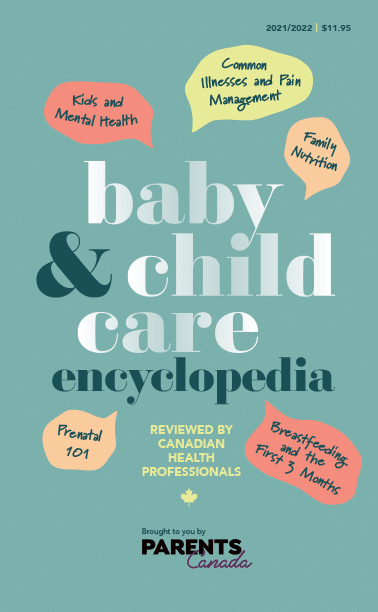From the pages of the Baby & Child Care Encyclopedia: Chapter 2, Breastfeeding and the First Three Months
I
f you feel like you’re examining your kiddo 24/7, don’t worry. You’ll feel better when you realize that everything is “normal” when it comes to how your baby looks, moves, sounds, eats and sleeps.
- Click here to read about their growing bodies
- Click here to read about health and behaviour
- Click here to learn more about bonding with your little one
Their growing bodies
Skin When they’re fresh out of the oven, most newborns are very red because they have a red blood count that is higher than an adult’s. Some babies are born covered in a white waterproofing” substance called vernix, especially under the arms, behind the ears and in the groin area. If you spot a skin rash, like tiny white spots on the nose, or acne, rest assured they’ll disappear soon. You might also notice birthmarks—sometimes they’re found over the eyelids or at the back of the neck. These flat, pinkish-red spots—dubbed “stork bites” often become more noticeable when Baby cries. They’ll also disappear.
Spots that look like bruises found just above the bum are called “Mongolian spots” and they’re caused by pigment in the deep layers of the skin.
If Baby was jaundiced in the hospital, it normally takes about four days before the skin loses its yellowish tinge. That said, babies who breastfeed can look yellow for several weeks, even though they’re thriving. You shouldn’t stop breastfeeding as long as your paediatrician has checked Baby and given the all clear. Jaundice will gradually disappear.
Fontanelle The fontanelle is the soft spot on your baby’s head—it’s the space between four of the growing head bones that’s covered by a tough inner skin and is well protected. Be mindful of it but don’t be afraid of washing your baby’s scalp.
Eyes Yup, babies spend a lot of time asleep. Still, when they do open those peepers, parents always want to know what colour their child’s eyes are. If your babe is born with brown eyes, he or she will always have brown eyes. But infants with blue eyes may not end up being blue-eyed down the road—it can actually take up to nine months before the final colour settles in.
If you notice your baby is waking up with runny eyes, little spots of yellow pus, or with his or her eyelids stuck together, it’s likely a blocked tear duct. It’s not serious and is easily treated with antibiotic drops. The tear duct often unblocks itself. (If it doesn’t, a doctor can fix it with a very simple procedure.)
Hair Some babies are born almost bald, while others are born with lots of locks. Don’t be surprised if some falls out soon after birth; it will grow back.
Genitals
Baby girlL: There may be some mucus coming from your baby’s vagina and even blood (pseudo-menstruation). This is caused by hormone changes and is nothing to worry about.
Baby boy: Your baby’s testicles may seem quite big, but this is completely normal. The tip of the penis is covered by foreskin designed to protect the tip of the penis. Don’t try to pull it back. When your child is older, it will loosen and it will be easy to wash underneath the foreskin.
Some parents opt to circumcise their sons, and they do so for a variety of reasons, including religious or cultural. Circumcision is a surgical procedure to remove the layer of skin (foreskin) that covers the head (glans) of the penis and part of the shaft. While it’s not medically necessary—and routine circumcisions are not currently recommended by the Canadian Paediatric Society—it’s up to parents whether or not they choose to go this route. Problems after circumcision are usually minor. Doctors say it’s important to keep the area as clean as possible, changing the bandage every time you change his diaper. Use petroleum jelly to keep the bandage from sticking. Get in touch with your doctor if you see more than a few drops of blood during the healing process (about seven to 10 days), if swelling persists after 48 hours or if he develops a fever.
Movements Your baby will sleep most of the time, but you will notice him or her moving around—babies stretch, sometimes tremble and often make suckling and eye movements. When babies are awake, their arms and legs will move in various directions, and they’ll grasp hold of anything placed near their hands. When tummy time is introduced, babies’ heads move from side to side. (Just be aware that neck muscles aren’t strong, and the head should be supported when Baby is lifted.) When it comes to sounds, don’t be startled by Baby’s reactions to loud noises—he or she might jerk and cry. They’ll just need a cuddle to calm down.
Reflexes Your babe is born with reflexes and these may be the most physical developments you see for a few weeks. These reflexes include sucking (they have a natural instinct to suck); rooting (the hunt for food is on—watch how Baby’s head turns when the nipple is offered); startling (when babies hear a loud noise or see a quick movement, they throw their heads back and extend their arms and legs, then draw back in); and grasping (your baby’s hand will curl into a grasp when his or her palm is touched).
Breathing You’ll start to get used to Baby’s breathing, and his or her wee sniffles, sneezes, coughs and hiccups. It’s totally normal to hear breathing that sounds irregular—sometimes slow, sometimes fast. And when babies get upset—we’re talking really upset—they’ll cry super hard and their skin might even turn blue for a few seconds. There are also abnormal things to watch out for, including constant, fast breathing or hard breathing during feeding. Call your healthcare provider if Baby’s skin looks blue or pale, or if you hear noises like grunting with breathing or wheezing coming from their chest.
Health and behaviour
Crying You know what they say—babies do nothing but eat, sleep, poop and cry. The last one is their way of telling you what they want or feel. Maybe they’re tired or hungry? Perhaps bored or uncomfortable? Too hot or too cold? Soon you’ll learn what all the different cries mean. The bottom line is a crying baby demands love and attention, so don’t hesitate to cuddle—you can’t spoil an infant. Just give into letting them feel safe, comfortable and content.
Colic First off, babies cry. All babies. There’s no skipping over the crying part. But some babies cry more than others and for longer periods of time. Those who bawl for more than three hours a day, more than three days a week, are likely to have colic. Colic goes away on its own but it can happen to the healthiest of babies between about two to five weeks—there’s really no rhyme or reason why some get it and others don’t. What’s more, medical experts aren’t even sure what causes colic—it could be anything from a food sensitivity or a digestion issue to just getting used to life outside the womb.
Colicky babies can be difficult to soothe. They have high-pitched cries, their limbs often stiffen and their backs arch. While there’s no “cure” for colic, there are ways to help. First, make sure they have a clean diaper and they’re not hungry. Start burping more during feedings. If bottlefeeding, try other types of bottles to see if Baby swallows less air or ask your healthcare provider if you should switch formula. Breastfeeding moms might want to consider cutting certain things from their diets, including caffeine, dairy, eggs and soy. Some babies calm down when rocked or when parents pace, and some find a pacifier helps.
Remember, it’s not unusual to feel anxious, panicked or frustrated if your baby won’t stop crying. If you’re alone with the baby, bring in reinforcements—your best bet is to call a family member or friend to take care of the little one and relieve you for a bit. If you don’t have anyone nearby to help, put the baby back in his or her crib, close the door and take a break. (Deep breathing or listening to music can help.) Check on him or her after 10 minutes. If you feel like hurting yourself or the baby, call 911. Never shake a baby.
Sleep Patterns Expect lots of slumber in those early weeks. Babies usually sleep for a couple hours at a time and then wake to be fed. (If your baby isn’t waking on his or her own, wake to feed after three or four hours.) Babies generally don’t sleep through the night (six to eight hours at a time) until they’re about three months old or older.
A reminder from the Canadian Paediatric Society: Babies should be put to bed (naps and for the night) on their backs, without anything in the crib with them (that means no blankets, pillows or stuffies). Sudden Infant Death Syndrome (SIDS) is much less common in babies who sleep alone in their own crib on their backs.
Common Newborn Ailments We know you’ll be keeping a close eye on every part of Baby, so you should definitely be aware of a few very common health issues. Some babies are born with blocked tear ducts, for instance, which are completely harmless. You might notice tearing or mucus in the corner of the eye, but by 14 days tear ducts usually open without treatment or intervention. Cradle cap is another one that most babies suffer from—you’ll notice a red scalp with heavy flaking that’s caused by a buildup of oil. It doesn’t look nice, but it doesn’t hurt. Simply wash his or her head with Baby shampoo often and use a soft brush to remove scales. The most common ailment is arguably diaper rash—pretty much every baby gets it, thanks to the moisture buildup under the diaper. To avoid rashes, change diapers more often and use barrier cream on the bum. If rashes persist, let your paediatrician know.
Bonding with your little one
Bonding Babies form very strong emotional bonds from the get-go and nurturing this bonding during the first few weeks is key. When you respond quickly to comfort his or her crying, Baby will learn to depend on you. Comforting babies is the best way to love them. Other ways to foster that bond include speaking and singing quietly to Baby, trading facial expressions and making time for skin-to-skin contact.
Baby Blues Mom, let’s be frank: Your hormones are all over the place, you’re beyond tired, you’re likely a ball of worry and you’re dealing with learning to be a parent. It’s totally normal for things to feel a little, well, out of control right now. If you’re feeling down, take heart. Feeling blue is common and doesn’t always lead to postpartum depression. Ask family and friends for help. While you’re at it, try to ease some of the pressure you’ve likely put on yourself—the less rigid you are, the better. If you feel like your worries or feelings of sadness are progressing, call your healthcare provider—they’ll put you in touch with someone who can help.
Read more from the Baby & Child Care Encyclopedia.

-
-
- Prenatal 101
- Breastfeeding and the First Three Months
- Starting Solids and the Toddler Years
- An Age-by-Age Guide to Sleep
- Family Nutrition
- Kids and Mental Health
- When Your Child is Sick
- Safety and First Aid
- Milestones, Checklists and Charts
-















